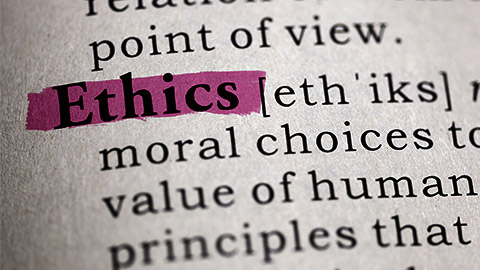In this section you will learn to:
- Identify the ethical framework that applies to practice management work.
- Incorporate practice considerations as part of ethical practice.
- Evaluate responsibilities to workers, clients and the broader community.
- Model ethical behaviour in own work.
Supplementary materials relevant to this section:
- Reading D: AAPM’s Code of Ethical Conduct
- Reading E: Example of Code of Conduct
So far, this module has focused on the legal considerations of practice management. However, as a practice manager, you may face many complex situations in which there is no relevant legislation to guide your actions. Instead, these situations will require you to consider all aspects of the problem to make an ethical judgment. This section of the module will explore the key ethical considerations of practice management.

An ethical framework refers to the system of principles, rules or standards by which human actions are judged right or wrong. All human service workers come to their role with their own values and beliefs that they need to be aware of and deal with on a daily basis.
(Community Door, 2018a)
Ethics are beliefs, standards, and motivations for behaviours that are valued by you as an individual or valued by a group.
While you will have your own ethical framework, all organisations and employers will have expectations regarding the way you are to carry out the tasks and duties inherent to your role.
An ethical framework for practice management may include any of the following:
- A code of ethics/practice/code of conduct
- Organisational policies and procedures
- Partnership agreements and memorandums of understanding
- Interagency and service collaboration agreements
- Information sharing protocols
- Conduct, complaints, and discipline procedures
- Commitment to reporting, monitoring and accountability practices
- Supervision and mentoring
- An oversighting/governing professional structure
- Training and professional development
- Professional accreditation
Having a thorough understanding of the ethical principles, codes, and practices of your organisation is vital to your practice, and will:
- Provide you with guidelines for appropriate practice
- Assist in your decision-making
- Help you to maintain a high standard of behaviour and practice
- Improve your effectiveness
- Help you successfully navigate ethical dilemmas.
Practice Standards
Practice standards refer to “what is required for effective, professional and accountable practice on a daily basis for workers operating in a particular field” (Department of Justice and Attorney-General, 2021, para. 5). Failure to meet practice standards may result in disciplinary or ‘fitness to practice’ hearings against an individual practice manager or whole organisation. In cases in which practice managers fail to meet minimum practice standards; they may also be liable for legal charges of negligence by clients.
As a practice manager, it is important for you to familiarise yourself with relevant national standards of practice, as well as any practice standards established within your own organisation, as this will help to ensure that you carry out your duties ethically and responsibly. Practice managers may also use practice standards to reflect upon and assess their practice and determine aspects that they could improve on. Joining a professional organisation can help ensure you keep up to date with required standards.
Policy Frameworks
There are also a range of national/state frameworks that specifically set out practice standards relevant to service delivery in particular sectors. As we touched on earlier in this module, practice management work spans across a wide variety of allied health sectors, including (but not limited to) physiology, occupational therapy, podiatry, psychology, general practice etc. Examples of corresponding framework documents include:
- Disability - National Standards for Disability Services.
- Mental health – National Safety and Quality Health Service Standards
- State/territory standards, e.g.
- QLD community and disability services - Human Services Quality Framework.
- NSW children and family services – Practice Framework Standards for child protection and out of home care practitioners.
- The Allied Health Clinical Governance Framework – provide support for allied health professionals to fully engage in clinical governance.
These practice standards and national/state policy frameworks can be used to inform organisations on how they can establish their own practice standards for use within their field of discipline – these are often communicated through organisational policies and procedures as well as code of conduct. As a practice manager, it is important for you to familiarise yourself with relevant national standards of practice, as well as any practice standards established within your own organisation, as this will help to ensure that you carry out your duties ethically and responsibly.
Codes of Ethics and Practice

The Australian Association of Practice Management (AAPM) is one of the professional bodies that seek to guide health administrators, medical receptionists, practice managers and other related professions in Australia, and you will be eligible to join this body once you have successfully completed your relevant qualification. The AAPM has developed a Code of Ethical Conduct, which outlines ethical principles (often referred to as code of ethics) and how these should be implemented in practice (otherwise referred to as code of practice).
Consider the following example of an ethical principle from the Code of Ethical Conduct:
“Members of AAPM endeavour to exercise their responsibilities reasonably and not arbitrarily or for some irrelevant purpose, having regard to the legitimate interests of other affected parties.”
(AAPM, 2023, p.12)
This means that health administrators should act in good faith with regards their client’s health and well-being.
An example of the related practice guideline from the Code of Ethical Conduct is:
“Provide comprehensive information that others need to know in order to make informed decisions.”
(AAPM, 2023, p. 12)
This guideline explains one of many ways that health administrators can ensure they act in good faith to ensure their clients health and well-being, as described in the ethical principle above, is preserved.Essentially, Codes of Ethics generally outline the core ethical principles that members are expected to abide by, while Codes of Practice set out guidelines about how allied health professionals should deliver services so that their practice reflects ethical principles. Failing to adhere to an ethical code can lead to a disciplinary hearing or expulsion from membership.
Reading
Reading D – AAPM’s Code of Ethical Conduct
A copy of the AAPM’s Code of Ethical Conduct is provided in Reading D. Take the time to review this before continuing because it forms the basis of the ethical practices you will be learning about in throughout this Study Guide.
Practice managers are responsible for protecting the rights of clients. The key responsibilities, adapted from AAPM’s Code of Ethical Conduct include:
- Respecting the basic rights of clients: clients have a right to receive service with integrity, respect, and dignity.
- Respecting the client’s right to privacy and confidentiality: clients deserve for their privacy and confidentiality to be respected.
- Prioritising client safety and well-being client communication and care should be presented in an open and effective way to promote health, wellbeing and safety.
- Delivering competent service: practice managers have a responsibility to deliver quality service through supervision and continual professional development and education where relevant.
Some of these principles are supported by legislation; others are predominantly expressed in ethical codes and practice standards.

Many organisations write their own code of conduct as well which means they are all slightly different and generally reflect the values that the organisation believes to be most important. The purpose of a code of conduct is to outline the organisation’s expectations about their staff’s performance and behaviour by indicating standards of governance, standards of behaviour and behaviours that are considered unacceptable. Organisations should also clearly set out the consequences for failing to comply with code of conduct as well as processes to determine, monitor and enforce these.
Codes of conduct take many forms; some are highly prescriptive, prohibiting certain actions or behaviours, while others are more principles-based. The common goal of codes of conduct is to provide guidance to the people involved with an organisation about how they are expected to behave. For this reason, it is common for codes of conduct to include a discussion of these expectations, relevant examples and links to relevant internal policies.
(Australian Institute of Company Directors, 2019)
Reading
Reading E: Example of Code of Conduct
Reading E provides an example of a code of conduct provided by Mission Australia. All employees, staff, and volunteers of Mission Australia are expected to behave in accordance with this code.
Overall, ethical frameworks are integral to the practice of practice management and are vital for protecting both client interests and the integrity of the sector. Although you may have the best intentions of conducting yourself responsibly and ethically as a practice manager, you are likely to face ethical dilemmas throughout your career – these ethical standards can help you appropriately address such dilemmas. The following case study offers an example of an ethical dilemma.
Case Study
Tristan has been working as a practice manager with a client, Albert, for several years. During that time, Albert’s family have come to appreciate the way that Tristan has cared for Albert and on several occasions have offered him gifts. Tristan has always politely declined and mentioned that his code of conduct doesn’t allow for it and the money is better off being used for Albert anyway.
Tristan is about to finish up with his current employer to return to full-time study and, on his last day, the family present Tristan with a card which they ask him not to open until he gets home. When Tristan gets home, he opens the card and reads the heart-felt message written by the family, including Albert, but is stunned when he sees a cheque taped to the back for a substantial amount. The cheque would be enough to cover his university costs for at least two years.
Tristan agonises over the decision but knows his code of conduct still applies even though he has left the organisation.
The next morning, he arranges to meet with his former manager and explain the situation. He hands the cheque over and asks the manager if he could return it to the family.
The above case study provides just one example of the types of ethical dilemma you may come across in your work. In reality, ethical dilemmas may take many forms and will often consist of ‘grey areas’ in which there is no clear-cut solution. In many cases, practice managers will need to draw upon the experience and advice of their supervisor to help them manage ethical dilemmas.
Self Reflection
Take a few moments to reflect upon your current level of comfort in dealing with ethical dilemmas. Do you think it would be beneficial discussing ethical dilemmas with your supervisor? Why?
There are several critical considerations for ethical practice management. We will discuss the most important of these now.
Duty of Care Principles and Practices

All practice managers have a duty of care towards their clients, which means that they must take all reasonable steps to avoid clients coming to harm through their actions or failure to act. Often an organisation will have a policy document that defines duty of care and outlines how a staff member can fulfil their duty of care requirements. An example of this is set out in the following extract.
Position Statement
The organisation has a Duty of Care to provide services and support in a manner that supports the safety, welfare and wellbeing of clients and their families. Duty of Care must be balanced with Dignity of Risk. This policy should be read in conjunction with the organisation’s policy on Dignity of Risk.
What is Duty of Care?
Everyone owes a duty of care to another person, if it can be foreseen that the person is likely to be injured or harmed (physically, economically, and emotionally) by the first person’s actions or failure to act. The law requires staff to take reasonable care in carrying out their work by ensuring that reasonable standards of care are met.
Fulfilling Duty of Care
The standard of care required to fulfil Duty of Care is assessed on what action a reasonable person would take in a particular situation. Duty of care is breached by failing to do what is reasonable or by doing something unreasonable that results, or could potentially result in harm, loss or injury to another.
To ensure Duty of Care obligations are met staff must –
- Recognise when people are at risk or injury from themselves or others;
- Determine when harm or injury is foreseeable;
- Not intentionally harm or injure another person;
- Safeguard others and support people to take risks as safely as is possible;
- Ensure clients are consulted, involved and informed in decision making;
- Ensure client’s rights are not compromised;
- Recognise that some risks are reasonable;
- Act within the organisation’s values;
- Seek advice and support when confronted with issues that challenge duty of care and dignity of risk;
- Avoid discrimination and overly restrictive options;
- Report concerns or incidents about the client’s safety;
- Seek medical advice about the clients decision making ability and Guardianship orders where necessary;
- Maintain appropriate documentation.
(Adapted from Community Care Options, 2017)
Negligence
In discussing duty of care, one must also consider the concept of negligence. Put simply, negligence means failing to act according to a reasonable standard of care, resulting in injury or loss to the client. This concept only applies to relationships where a duty of care exists, such as in the relationship between a practice manager and their client. Note that while duty of care is not in any legislation, negligence of duty of care can attract legal consequences under common law. Another aspect to consider here is what ‘reasonable standard of care’ means for the profession in question. In the event of a negligence lawsuit, the court will need to determine what standard of care to apply in order to determine whether a practice manager’s actions are negligent or not. This involves consideration of the practice standards commonly accepted by the profession.
As a practice manager, it is extremely important for you to ensure that you are always taking the safety and wellbeing of your clients into consideration, and that you are not negligent in your duty of care responsibilities. The following extract explains the concept of ‘negligence’ and the factors involved in determining whether a practice manager’s actions are negligent or not (i.e., malpractice).
To succeed in a malpractice claim, these four elements of malpractice must be present:
- a professional relationship between the [helper] and the client must have existed;
- the legal duty based on this relationship must have been breached: the [helper] must have acted in a negligent or improper manner, or have deviated from the “standard of care” by not providing services that are considered “standard practice in the community”;
- the client must have suffered harm or injury, such as emotional distress or physical harm, which must be verified; and
- there must be a legally demonstrated causal relationship between the practitioner’s negligence or breach of duty and the damage or injury claimed by the client.
(Corey, Corey & Corey, 2019, p. 192)
Case Study
Sally is a practice manager. One of the organisation’s clients, Brad, is experiencing depression. While talking with Brad, he discloses that he often cuts his arms and legs and that this makes him feel better. Sally considers her duty of care as well as the policies and procedures of her organisation to decide upon an appropriate course of action. She tells Brad that she has a duty to act on this information and contacts her supervisor. Sally’s supervisor advises Sally to organise an immediate referral for Brad for a specialist mental health assessment. Despite the need to break confidentiality, Sally upheld her duty of care to keep Brad safe and, after receiving some counselling and support, Brad is faring much better.
As you can see in the above case study, Sally fulfilled her duty of care to Brad by informing her supervisor of Brad’s self-harming behaviour and arranging for an appropriate referral. However, if Sally had failed to act in response to Brad’s disclosure, and that failure to act had resulted in Brad becoming injured or suffering harm, Sally would likely be considered to have been negligent.
While negligence focuses on failure to fulfil duty of care where it should be, dignity of risk is another practice consideration that focuses on over-protecting client to the extent that hinders their right to self-determination.
Dignity of Risk

The term ‘dignity of risk’ is used in relation to allied health as part of a recognition that a client may need to take appropriate risks to grow, develop, and add meaning to their lives.
Dignity of risk is tied up with duty of care. Practice managers have a responsibility to prevent clients from coming to harm; however, clients also have the right to take risks, fail, and learn from their mistakes. If practice managers act to prevent every conceivable type of risk, their clients may not get the opportunity to experience some of the same life events as their peers.
Dignity of risk recognises that the ability to take risks can help a person to grow and develop, and can give meaning to a person’s life. It also envisages that sometimes informed risk-taking will fail.
A human rights approach to risk management promotes the active participation of an individual in the assessment and management of their own risk. In this way, a service-user is viewed as ‘an active citizen with rights and responsibilities’ and as ‘an expert of his/her particular life circumstances’.
(Victorian Equal Opportunity & Human Rights Commission, 2014, p. 14)
Australian health and community services tend to err on the side of caution when it comes to risk, whereas dignity of risk introduces the concept that a little risk in life is enriching and promotes learning. The extract below refers to disability workers, however, it is equally relevant for practice managers in relation to balancing dignity of risk with duty of care.
Courts and the law of negligence do not therefore, expect disability workers to shield their clients from all possible risks. They do, however, expect workers to take reasonable care (to be sensible and cautious) in their work.
(National Disability Services, 2015, p. 10)
Ultimately, practice management principles and codes of ethics highlight the importance of empowerment. Practice managers should presume that clients are competent in assessing and acting on their own interests. However, there will be times as a practice manager when you need to consider your duty of care and dignity of risk, so that you are not negligent. To balance the risks involved, a practice manager may need to help the client consider the risk they are proposing to take. In order to assess and balance your duty of care and dignity of risk responsibilities, you should support client to consider the following points:
- Assess the possible harm and see how likely it will be to occur and, if it does occur, to what extent the harm would be.
- Assess the likely benefits that the client might gain from the activity and the extent of these benefits.
- Actively look for ways to reduce the risk of harm without losing the benefits of the activity.
- Assess the possible harm against the benefit.
Managers and supervisors need to monitor their staff to ensure that they are behaving appropriately and professionally at all times. Additionally, individual practice managers need to ensure that their actions are focused on protecting their clients from unacceptable risks and harm, and that they are not engaging in illegal or unethical behaviours. If, as a practice manager, you ever have doubts or suspicions about the legality of yours or another colleague’s actions, you should always make sure to report it and seek advice from your supervisor or manager.
Practitioner-Client Boundaries

One of the most difficult balancing acts practice managers perform is being friendly and empathetic while maintaining professional boundaries with clients.
It is the practice manager’s responsibility to establish and maintain professional boundaries from the outset of working with any clients. This is important for protecting clients’ right to safety and wellbeing and eliminate potential of exploitation within such relationship. On the other hand, maintaining these boundaries serve to protect the worker’s right and avoid violation arising from a client’s behaviour (e.g., a client may request to become friend with the practice manager on social media platform).
Practice managers should be alert to signs of boundary violations, some of which are outlined in the extract below.
- Developing strong feelings for the client;
- Spending more time with this client than others;
- Having very personal conversations with the client;
- Receiving calls at home from the client;
- Receiving gifts;
- Doing things for a client rather than enabling the client to do it for themselves;
- Believing only they can offer the right services to the client;
- Physically touching the client.
Whilst in isolation none of these behaviours may indicate a potential boundary violation is happening, they could be indicators of a potential problem.
(Community Door, 2018b)
Due to the broad variety of work contexts, professional boundaries of a practice manager will generally be determined by the organisation that you are working in. Take “receiving calls at home from the client” for example, if you work in crisis services and you are rostered to be on-call to address any client emergencies, you will likely be receiving calls from client at home. In this case, it will not be considered an unethical conduct. As such, organisations must make sure that they develop policy and procedures and/or code of conduct to provide clear, specific information on staff behaviours that are appropriate and inappropriate. It is the workers’ responsibilities to make sure that abide by these standards.
Work-Role Boundaries
Another important consideration relating to boundaries is the scope of work role. In general, a practice manager’s role is to support clients with assessment, accessing services, and/or advocacy. Practice managers do not usually act on behalf of or make any decisions for a client.
Essentially, practice managers must develop a clear understanding of what is and is not within their role, as set out by their organisation. They must also identify when a task or issue may be out of their role and/or expertise. Practice managers must be vigilant about establishing clear roles and boundaries from the outset and maintaining consistency throughout their work with clients.
Typically, the scope of your role is set out by your position description. Your organisation should provide clear guidelines around what is within your scope, and what needs to be referred on to the manager or other appropriate practitioners/services. For example, when it comes to developing policies and procedures, a practice manager may be engaged in consultation, research, and drafting a policy, as well as finalising, implementing, and distributing the policy document. It may also be your responsibility, as a practice manager, to review and approve administrative requests, such as a client requesting a fee reduction. Realistically, the organisational guidelines may not cover all possible client requests or situations; in these cases, or where scope of practice outlines otherwise, the practice manager may need to report or refer to a supervisor or manager.
Continuing Professional Development

Practice managers have an ethical responsibility to continually add to their knowledge and skills in order to remain uphold current best practice and standards. Practice managers may work with clients with vastly different challenges and issues, as is the nature of working with people. As a practice manager, you will likely start out in your career with some knowledge and training; however, as you gain more experience, you will quickly realise that there is always more to learn.
Some general strategies which may be useful for continuing your professional development as a practice manager include:
- Asking about internal training opportunities offered by your organisation.
- Engaging in professional training and development courses offered by professional associations or accredited training services (e.g., T.
- Engaging in self-study or educational courses through an approved provider (e.g., e-learning, certificates, diplomas).
- Attending professional workshops, seminars, conferences, and lectures.
- Engaging in self-directed learning activities (e.g., TED Talks, YouTube, Google Scholar).
- Reading books, journal articles, websites, and professional blogs, and listening to podcasts.
Typically, organisations will have professional development or education requirements in place to make sure that their staff receives sufficient and updated training required to carry out work in a safe and ethical manner. In some cases, training may be a legal requirement, for example, if First Aid Certificate is required for a role, the organisation must ensure that the staff renew their qualification periodically. In other cases, training may be required to improve ethical compliance, such as learning about the evidence-based practices within the sector.
Overall, as employees, you have a right to be provided with training required to carry out your duties; as such, your employer is responsible to allow access to relevant development/training opportunities. However, it is your responsibility to make sure you fulfil these requirements within time frame and keep track your learning. If this is not done, your employer may have the right to dismiss staff who fail to comply. Often, organisations will have a training register to document and monitor whether staff has completed their professional development requirements. It is important that you figure out what those requirements are for your specific role and context.

Unlike the legislative requirements, ethical considerations are not usually as clear-cut; ethical responsibilities of a practice manager will largely depend on their work context and the responsibilities they have to others in your workplace, clients, as well as the broader community. As you begin your career as a practice manager (or any role you may undertake in life), it is important to take time to identify and determine the ethical framework that applies to your specific role and work context.
To begin with, consider the range of documents and principles we have discussed up to this point of the module. Fundamentally, human rights and legal considerations will be the foundation to understanding your ethical responsibilities. On top of that you must be familiar with the code of ethics or ethical principles that guide your role, including those that we have discussed earlier on. For example, you may refer to the Code of Ethical Conduct developed by the AAPM or the code of conduct and policies and procedures in your organisation.
You will also need to consider what is and isn’t within your scope of practice. For example, an elderly client tells you about a potential financial abuse that they are experiencing from a family member. It may not be in your role nor expertise to address this issue directly; however, you still have an ethical responsibility to refer this client to an appropriate support and/or to report this issue as per your organisational procedures. In this situation, working ethically involves considering how the way you respond and the actions you take could impact on this client’s wellbeing.
Case Study
Jenny is a practice manager in a local allied health organisation. One of her colleagues, an allied health assistant, has reported to Jenny an incident that may have violated ethical principles. As a manager, Jenny is clear about the ethical frameworks that guide practice management and knows that this staff may have breached code of conduct. However, Jenny knows that this matter is best referred to the manager of this staff, likely the allied health professional, as it will not be in her role to manage this issue. She decides to bring this issue to the other team leader of this staff.
Taking this to a broader level; administrative decisions made on the organisational level, such as in service delivery, policies and procedures, and approach towards ethical issues, can have wider impacts to relevant workers, clients, and the broader community. Let’s imagine that due to lack of funding, an organisation reduces the number of staff but asks all remaining staff to increase their workload to meet the service requirements. Workers are experiencing high level of frustration, disappointment, and burnout, affecting the quality of support clients receive. Some clients had to be turned away due to lack of availability and become more reluctant about seeking assistance in the future. All of these impact on the clients and their families and support network who are already under tremendous pressure. Overall, the broader community has lost its confidence in the allied health service and is now struggling to address its people’s needs and pressing societal issues.
This is of course an overly simplistic, hypothetical example, as there are likely to be more complex factors at play. However, it illustrates the importance for managers and decision-makers of health and community service organisations to evaluate their responsibilities to workers, clients, and the broader community in every service decision they make. Ethical principles remain important throughout every aspect of the organisation’s operations. For this reason, following a structured approach in making ethical decisions, such as the decision-making model that we discuss below, can be beneficial for meeting ethical requirements. This model can be useful for a practice manager who is facing an ethical dilemma in client work as well when considering legal or ethical responsibilities in addressing an issue so as to develop a justifiable, appropriate course of action.
Ethical Decision-Making

Below is a simple model for ethical decision-making which can help guide practice managers when planning actions or making a decision. As you will notice, legal and ethical obligations are naturally embedded as part of the considerations as they are fundamental to supporting good decision-making. In addition, you will also need to consider what your responsibilities and duties are to workers, clients, and the broader community who may be impacted.
Step 1: Identify and assess the situation
- What do I want to do?
- What are the facts and circumstances of the situation?
- Does it break the rules, the law, or is it inconsistent with government policy?
- Is it consistent with my obligations under the code of conduct?
- Is it consistent with my obligation under my professional code of ethics?
- What ethical principle or principles does it relate to and why? [...]
- Who is affected and are other people involved?
Step 2: Look at the situation from [an allied health] sector standpoint
- What is my duty as a [practice manager]?
- What legislation, policies, procedures or guidelines are relevant?
- Who should I consult?
Step 3: Would my actions or decision withstand public scrutiny?
- Would a reasonable person consider that I was in a position to improperly use my powers or position?
- Would the public perceive my action or decision as honest or impartial?
- Is there a conflict of interest?
Step 4: Identify and consider the options
- Who is the best person [...] to provide me with advice?
- What are my options and the likely consequences?
- Are these options consistent with [...] ethics principles in the Act?
- How would the public view these options?
Step 5: Choose your course of action
- Is my preferred action within my authority?
- Is it fair and can I justify it?
- How will I document my action?
- Who will I involve to check that this is the correct action to take?
(Community Door, 2018c)
Modelling Ethical Behaviour
It is also worth mentioning that ethical principles are not only for situations when a decision needs to be made or an ethical dilemma is encountered. Ethical values and principles need to be embedded into our day-to-day life. As a practice manager, clients and your co-workers will be watching what you are doing and how you respond to situations. How you approach your ethical responsibilities will likely influence those guided by you. Imagine that you are working with another team leader who favours one worker over the others. What impacts might this have on the morale of the team, and subsequently their capacity to collaborate for quality services? If a practice manager is not complying with their own code of conduct, what impacts do you think that will have on their clients? Would they be perceived as trustworthy and professional?
In other words, one way to uphold ethical practice is to make sure that you demonstrate ethical behaviours, whichever role you may take in the organisation. This is why most organisations would require their staff members, management, and volunteers to behave in accordance with code of conduct, to promote an ethical culture in the organisation. Your code of conduct is likely to cover not only behaviours when carrying out client or service activities, but also how you present as an employee in front of co-workers and members of the public.
Practice managers often work with vulnerable clients who may be dealing with difficult life circumstances and who may not have had positive role models in their life. Behaving authentically and ethically helps you to set a good example for your clients and colleagues and helps them to aspire to higher standards in their own work and personal lives. Ethical work practices also often have the added benefit of helping you to gain the respect and trust of clients and colleagues, thus enabling you to work more effectively with them. This is demonstrated in the case study below.
Case Study
As a practice manager, you observe your staff members interacting with clients. Jerry is one of the health administrators you oversee. He often tries to make clients feel comfortable by talking about some of the ‘best’ and ‘worst’ client cases he has seen over the years. He also tries to reassure clients about their own issues by telling stories and jokes about some of his own escapades.
Another worker, Greg, also feels it is important to build rapport with clients but is always careful not to talk about previous cases with his clients. He is honest and trustworthy and truly cares about clients and will take the time to listen to them. Greg tries to set a positive example for clients by emphasising the importance of making healthy lifestyle choices. He provides clients with examples of healthy habits he himself engages in in his own life, such as gardening, and sports activities.
Although Jerry gets on well with his clients, he has noticed that many of them don’t seem to be engaging well. When he asks for feedback on his practice, one of his clients tells him that she doesn’t feel comfortable telling him personal details about herself, as she is concerned that he will tell other people. Conversely, most of Greg’s clients indicate that they felt safe to share important information or discuss problems with Greg, and that his positive example helped to encourage them in their own recovery.
In this section of the module you have learned about the ethical framework of practice management, including how codes of ethics and codes of conduct inform ethical practice. You have also learned about some of the key ethical considerations that practice managers need to be aware of, including how to maintain professional boundaries, as well as how professional development help to ensure that work practices remain ethical. Essentially, ethical principles need to be embedded into every aspect of allied health, not merely in client-facing roles. The leaders in the organisation must become ethical role models to implement an ethical culture among workers which promotes a commitment to ethical practices. This includes following structured decision-making model to make sure they have considered responsibilities to all workers, clients, and the broader community. In the next section, you will learn more about how policies and procedures are used to support and monitor compliance with the legal and ethical requirements we have discussed so far.
- Australian Association of Practice Management Ltd (AAPM). (2022). Code of Ethical Conduct. 2nd Ed. https://www.aapm.org.au/Portals/1/AAPM%20Code%20of%20Ethical%20Conduct_FINAL_12OCT22.pdf
- Australian Institute of Company Directors. (2019). Principle 9: Conduct and compliance. http://aicd.companydirectors.com.au/resources/not-for-profit-resources/not-for-profit-governance-principles/principle-9-conduct-and-compliance
- Department of Justice and Attorney-General. (2023). Practice principles, standards and guidance. https://www.justice.qld.gov.au/about-us/services/women-violence-prevention/violence-prevention/service-providers/practice-principles-standards-guidance#:~:text=Practice%20standards%3A,are%20expected%20to%20be%20conducted
- Australian Human Rights Commission. (n.d.) Workplace discrimination and harassment policy template. https://humanrights.gov.au/our-work/employers/workplace-discrimination-and-harassment-policy-template
- Community Door. (2018a). Introduction. In Section 2: Working within an ethical framework. Queensland Council of Social Service.
- Community Door. (2018b). Professional boundaries. In Section 2: Working within an ethical framework. Queensland Council of Social Service. https://etraining.communitydoor.org.au/resources/etraining/units/chccs301a/section2/section2topic05.html
- Community Door. (2018c). Working within an ethical framework. In Section 2: Working within an ethical framework. Queensland Council of Social Service. https://etraining.communitydoor.org.au/resources/etraining/units/chccs301a/section2/section2topic10.html
